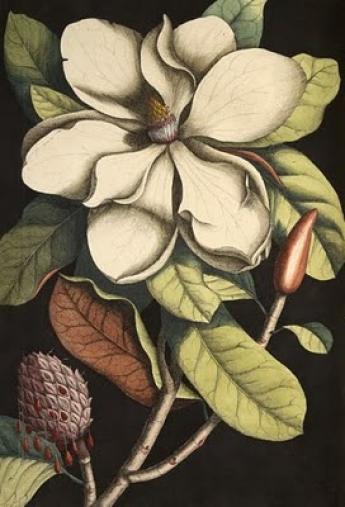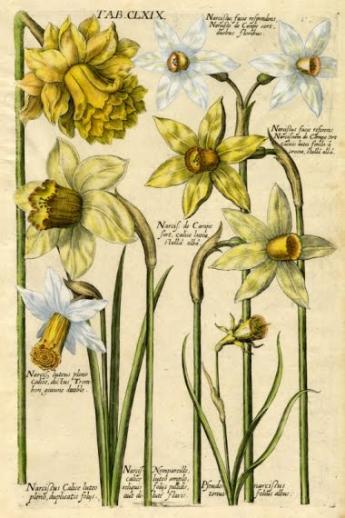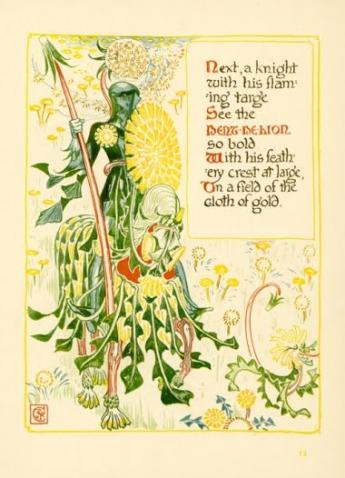Reading The Landscape At The Sterling Morton Library

By Nancy Mattoon
Summertime is almost here, and the living should be easy. But if you want your plants to grow as high as the cotton in Porgy and Bess, early summer is also the time to take Candide's advice to tend your own garden. The Sterling Morton Library, located at the Morton Arboretum in Lisle, IL., has created a virtual exhibit so beautiful that even those in the grip of early midsummer malaise will be inspired to get out the gardening gloves.
The online exhibit, Flora! Illuminated is a companion to an in-house show featuring "spectacular plant images" from the library's rare book and art collections, accompanied by "snippets of song lyrics, poetry, and prose." The Sterling Morton Library specializes in botany, horticulture, botanical art, forestry, landscape design and architecture, and natural history. Among its holdings are 5,000 rare books dating back to 1482, and 800 journal titles beginning as early as 1793. Also housed at the library is an art collection of 12,000 engravings, lithographs, watercolors, pen and ink drawings, and landscape renderings by significant Midwestern prairie school designers. The Sterling Morton Library is also the archive for the Morton Arboretum.
The Morton Arboretum, covering 1,700 acres, is located 25 miles west of Chicago. It was established in 1922 by Joy Morton, who earned millions by founding The Morton Salt Company. (A love of nature ran in the family: Joy Morton's father, Julius Sterling Morton, was instrumental in the creation of Arbor Day. The Morton Family's motto was "Plant Trees.") Joy Morton's 700 acre estate was the seedling from which Arboretum's forest of 4,100 species of trees, shrubs, and woody plants grew-- and also its 10 gardens and the Schulenberg Prairie, one of the oldest and largest replanted prairies in the United States. The initial book collection of The Sterling Morton Library consisted of works transferred from the private library at Jay Morton's mansion, Thornhill.
Among the Morton Arboretum's gardens are a half-acre fragrance garden hosting 95 sweet-smelling species; an herb garden featuring plants used for flavoring food, curing illnesses, relieving the symptoms of ailments, and manufacturing products like soaps, perfumes, and insect repellents; and a one-acre maze garden, which may be closed during severe weather to prevent visitors from ending up like Jack Nicholson in The Shining. For Booktryst's purposes however, no garden is more important than The May T. Watts Reading Garden.
There is good reading on the land, first-hand reading involving no symbols. The records are written in forests, in fencerows, in bogs, in playgrounds, in pastures, in gardens, in canyons, in tree rings. The records were made by sun and shade, by wind, rain, and fire, by time; and by animals. As we read what is written on the land, finding accounts of the past, predictions of the future, and comments on the present, we discover there are many interwoven strands to each story... May Theilgaard Watts, preface to Reading the Landscape: An Adventure In Ecology, 1957.
Reading the landscape like a book, and writing poetically of its flora and fauna. That is the legacy of May Theilgaard Watts (1893-1975): ecologist, educator, naturalist, author, illustrator, poet, artist and visionary. She was the first staff naturalist at the Morton Arboretum, teaching classes on plant identification and in the then new field of "ecology." A strikingly tall and slender Dane, with a long braid pinned atop her head like a crown, she reminded one former pupil of "a Viking princess." She published two standard texts used for decades by teachers of landform geography, and dozens of plant identification books filled with her own pen and ink illustrations. (She had a degree in Botany from the University of Chicago, but had also studied drawing at The Art Institute of Chicago.)
In a perfect blend of her many talents, in 1963 May T. Watts was asked to design a "reading garden" next to the Sterling Morton Library. This small and secluded garden was designed to be the perfect spot for reading a favorite book, or for perusing one borrowed from the adjacent library. Working alongside librarian Mary Moulton, the Sterling Morton Library's first librarian, Ms. Watts chose plants that would flourish despite the Arboretum's harsh winters and hot, sticky summers, and were also "intriguing and unusual." One of those plants, a flowering lily-like species with white-edged green leaves, was named Hosta May T. Watts, in her honor.
Current Reference Librarian and Special Projects Cataloger Nancy Faller is bringing the library that has been called "The Jewel Of Lisle" into the digital age. She writes the Sterling Morton Library's blog, has just created its first Facebook page, and also co-curated (along with Rita Hassert, Technical Services Librarian, and Arlene Widrevitz, Assistant in the Rare Print Collection) both of the marvelous Flora! Illuminated exhibits: the in-house and the online. When you check out the online exhibit, be sure to investigate some of the hyperlinks included, as they lead the reader on many fascinating botanical adventures. Almost enough to make the virtual visitor quit longing to see the Illinois arboretum in person, but not quite... But hang on Voltaire, there's always your own garden to tend.
>>> Flora! Illuminated
>>> The Sterling Morton Library
The article is published on BOOKTRYST - A Nest for Book Lovers. It is presented here by permission of the author and Stephen Gertz.



